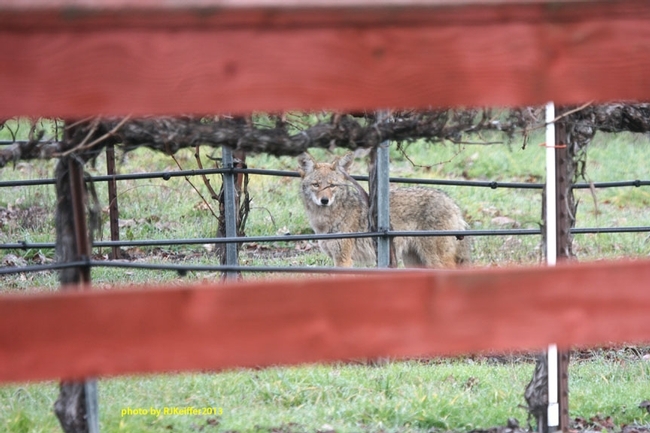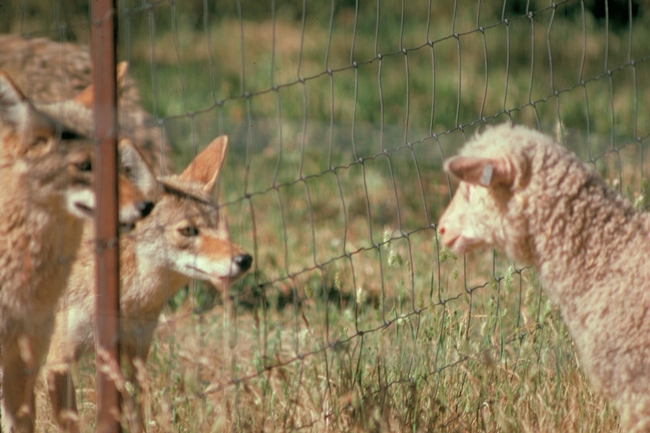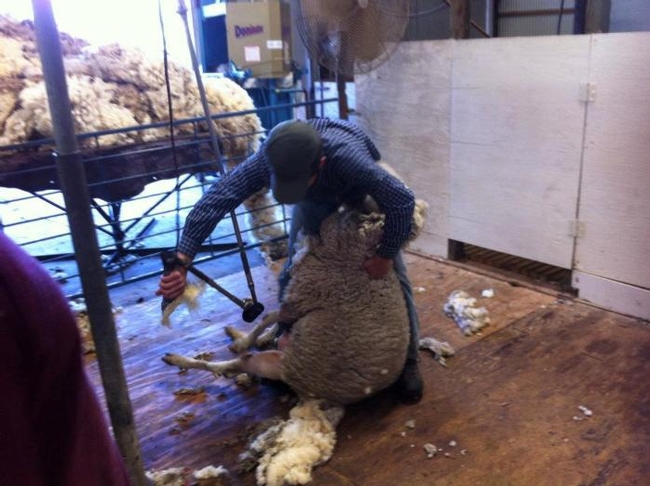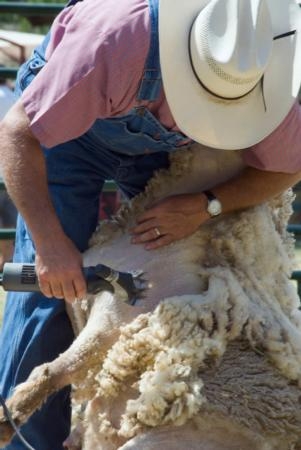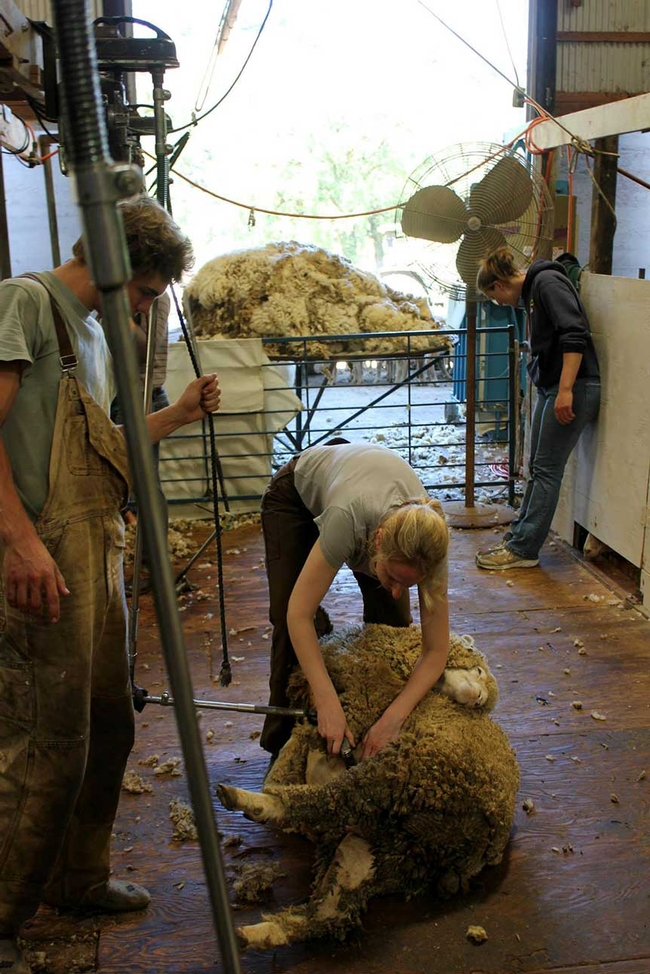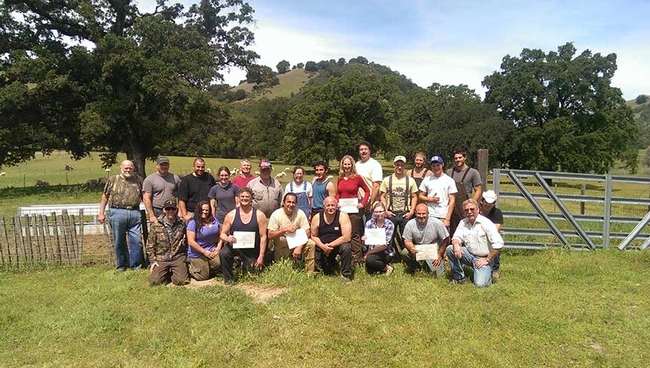Posts Tagged: sheep
Non-lethal predator wildlife control helps keep livestock safe
Five guard dogs are part of the team protecting sheep at a UC Agriculture and Natural Resources (UC ANR) research center in Mendocino County. The director of the UC Hopland Research and Extension Center (HREC) Kim Rodriguez is optimistic the dogs and other non-lethal wildlife control efforts being used at the station will allow peaceful grazing animals to share land with natural predators, reported Sarah Reith in the Ukiah Daily Journal.
Rodrigues initiated a new standard operating procedure (SOP) at Hopland early this year for predator animal control. The policy involves guard dogs, improved fencing and pasture management to protect sheep from coyotes, rather than shooting the predators. Jim Lewers, senior animal technician at HREC, said the "losses have declined" since the new policy was put in place.
Hannah Bird, HREC community educator, said 10 sheep at the center were killed by coyotes in 2015, while 43 were killed in 2014.
Rodrigues told the reporter that it is hard to attribute declines in animal deaths to a single strategy. She hopes to eventually make Hopland a hub for research and information sharing with local landowners on wildlife control.
That effort begins next week. On Dec. 1 and 2, HREC will offer two separate workshops on wildlife management. The first day will include representatives from USDA Wildlife Services, the California Dept. of Fish and Wildlife, and Defenders of Wildlife. On the second day, local ranchers and UC ANR representatives will speak about their chosen methods of wildlife management. Registration is $30 per day. Registration for the two days is separate, and the deadline is Saturday, Nov. 28.
Click here to register for the Dec. 1 workshop.
Click here to register for the Dec. 2 workshop.
Living with wildlife while managing working landscapes
The UC Hopland Research and Extension Center (UC HREC) will host workshops on Dec. 1 and 2 to foster understanding and encourage community dialog about ranching on a landscape with populations of coyote, black bear, mountain lions and other wildlife.
“Mendocino County supports many ranchers and our communities enjoy locally produced lamb, beef, milk, cheese and other agricultural products,” said Kimberley Rodrigues, director of UC HREC. “Along with these opportunities come challenges associated with living alongside some of our resident wildlife. The workshops will help local residents deal with these challenges.”
Rodrigues – who has a doctorate degree in environmental science and has been a leader in outreach, strategic facilitation and partnership development for 25 years – has been actively involved in wildlife management at the 5,300-acre HREC since she arrived in mid-2014.
“I quickly realized the biggest challenge to maintaining a sustainable flock of sheep here in our location is addressing predation issues, primarily by coyotes,” Rodrigues said. “With some improvements to our fences, changes in pasture rotations and increased use of guard dogs, losses of sheep to coyotes are now at an acceptable level. We hope to share our own experience, hear from diverse perspectives and experiences at these events and would like HREC to become a hub for future learning on this topic.”
Recent discussion and decisions made by the Mendocino County Board of Supervisors regarding their contract with USDA Wildlife Services (WS) and their use of an integrated wildlife damage management program prompted UC HREC to provide a space for two workshops to allow learning on wildlife management and community conversation.
The Dec. 1 workshop will focus on scientific design and is implemented by USDA WS. It provides an opportunity to hear experts from USDA, the Californi Department of Fish and Wildlife, UC Cooperative Extension and Defenders of Wildlife to discuss the most up-to-date research in wildlife behavior and non-lethal control methods.
The Dec. 2 community conversation workshop is hosted by UC HREC and includes current research from UC Agriculture and Natural Resources, wildlife biologists and discussion of the challenges associated with ranching in Mendocino County from the Magruder family and other local ranchers. The day will culminate in discussion groups on topics ranging from integrated wildlife management tools to understanding local, state and federal connections.
The public may attend either day or both days. Registration for the two workshops is separate.
“Topography, surrounding environments, community viewpoints, available funds and the kind of animals being farmed are all part of the picture – there is no easy solution,” said Hannah Bird, UC HREC community educator. “Ranchers and land managers need to know what tools are available to them and the implications and benefits of each of these tools. Attending both workshops will provide a deeper understanding of the issues.”
Community members, ranchers, land managers and members of non-profit organizations are invited to attend. The workshops will be at the Rod Shippey Hall, Hopland Research and Extension Center, 4070 University Road, Hopland, CA 95449. Registration is $30 for each day (including lunch) and must be made in advance. The registration deadline is Nov. 23. Space is limited.
Sign up for the Dec. 1 USDA WS workshop at http://ow.ly/TYhBd and the Dec. 2 community conversation workshop at http://ow.ly/TYhos.
More on the University of California Hopland Research and Extension Center:
The Hopland Research and Extension Center is a multi-disciplinary research and education facility run by the University of California, Agriculture and Natural Resources Division. As stewards of more than 5,300 acres of oak woodland, grassland, chaparral, and riparian environments their mission is to find better ways to manage our natural resources and conduct sustainable agricultural practices, through science, for the benefit of California's citizens.
Author: Hannah Bird
Software developer quits job to shear sheep
"This year, I was on a ranch almost every weekend from January through June," Wilke said. "I got pretty burnt out."
With skills honed in three five-day sessions of training at the UC Agriculture and Natural Resources facility in Hopland, she has found she can earn between $50 and $100 per hour shearing sheep.
John Harper, UC ANR Cooperative Extension advisor in Mendocino County, has hosted the sheep shearing school for 20 years and has 40 years experience with sheep shearing.
"It is the longest running shearing school in California and I believe it's currently the only one," Harper said.
The training school started with instructors imported from New Zealand. When the cost of travel became prohibitive, Harper brought in Mike McWilliams from Oregon. Later Gary Vorderbruggen, who trained under McWilliams, became the chief instructor.
The five-day course will be offered again in 2016 with classroom instruction, demonstrations and hands-on experience. Beginning and experienced shearers have the opportunity for one-on-one training. Class dates have not yet been decided. Registration information will be posted on the Sheep Shearing School webpage.
View a PDF version of the Sheep Magazine article by clicking the link below.
Sheep Magazine article
UC ANR workshop inspires economic development
UC Agriculture and Natural Resources (UC ANR) is helping get a new industry off the ground in Mendocino County, reported Justine Frederiksen in the Ukiah Daily Journal.
The UC Hopland Research and Extension Center, a UC ANR facility, hosts an annual Sheep Shearing School, thought to be the only one in California. The students take a five-day hands-on course to learn how to maintain a quality wool clip and minimize stress to the sheep.
"It's like learning to square dance," said instructor Gary Vorderbruggen. "Except you're learning to dance with an unwilling partner."
UC ANR Cooperative Extension natural resources advisor John Harper facilitates the school in Mendocino County.
"I always say, you'll never be unemployed if you learn how to shear," Harper said. "There's never enough shearers."
One local resident who attended Sheep Shearing School twice, Matthew Gilbert, was inspired to open a local wool processing enterprise.
"It's the perfect fit for this county, because it will provide jobs for this rural economy," Harper said.
Many wineries are using sheep to clip cover crops because the sheep can't get up on their hind legs like goats to reach the foliage. Even as more sheep are working local vineyards, "we're losing the infrastructure to support the (sheep) industry," Harper said.
Last week, the Ukiah Planning Commission unanimously approved permits for Gilbert to operate a wool mill and food truck on his property, said another article in the Ukiah Daily Journal. The food truck will help supplement the family's income for the first couple of years until the mill becomes established.
Further enhancing local interest in the Mendocino County sheep industry, the Hopland REC hosts a Barn to Yarn event from 10 a.m. to 2 p.m. May 23. Visitors will see shearing, spinning and weaving demonstrations and learn how to class wool and dye it using Kool-Aid. Admission is $5 per person, and children under 12 are free. The Hopland REC is at 4070 University Rd., Hopland. For more information, call Hannah Bird at (707) 744-1424, ext. 105.
Mozilla information scientist finds her passion at UC Sheep Shearing School
It's May in Hopland, and the sparse winter rains are nothing more than a memory. Sharpened shears at the ready, Stephany Wilkes, an information science Ph.D. who works for Mozilla, walks a 150-pound sheep into the shearing area. Under the watchful eye of expert instructors, she flips the sheep on its side and starts methodically removing the fleece, smoothing the skin with her left hand, clippers in her right, moving the sheep with her legs.
“It's like a dance,” she says. “Once you have it right (and I mean, really have it), suddenly the whole method makes sense. You expend much less energy. You're controlling the sheep with your legs, which leaves your hands free, one to hold the shearing hand piece and the other to smooth out the skin so you don't nick the sheep.”
Since there are 400 ewes whose fleeces must be shorn before the hot summer months, that's important for her and her classmates.
The University of California Cooperative Extension Sheep Shearing School is the only program of its kind in California. It has been run in Mendocino County since at least 1990, but in 2009, it moved to the Hopland Research and Extension Center south of Ukiah.
Students are taught the New Zealand method of shearing, where the entire fleece is cut from the sheep as a single unit so it can be sorted and graded according to micron count. The method is designed to be comfortable for both shearer and sheep.
John Harper, UCCE natural resources advisor for Mendocino County, has been running this program for more than 20 years. Although these sheep weigh enough to make handling them a workout, he says that hip flexibility is more important than upper body strength. Since this is something women tend to have more of than men, they are often successful students.
More than 250 students from across the western U.S. as well as Canada and Mexico and have graduated from the program. Many come back year after year to practice under supervision, but also to connect with each other.
This year, a wool grading section was added to the course, taught by Ron Cole and Rodney Kott. Sheep have recently been bred much more for meat than wool in the region but there is a growing demand for high quality fleeces. The finest merino sheep do not do well in damp North Coast conditions but thrive in the dryer Central Valley and foothills, and there is a need for trained graders. Only 3 percent of California's 5 million pounds of wool is currently being processed within the state, and yet California remains a net importer of wool goods, while falling second only to Texas in sheep production. California fleeces are either composted or sent to China for processing, something another graduate of Shearing Class, Matt Gilbert, is keen to avoid.
“There used to be lots of mills in the U.S. to process our wool,” he said. “Now there are hardly any. That's why I wanted to start my own mill to process fine wool. We will be selling to handspinners and knitters and to commercial textile manufacturers. It's about trying to keep the product of this place in the region.”
Gilbert was inspired by the Fibershed movement started by Rebecca Burgess in 2010. Drawing on the locavore movement, Burgess committed to clothing herself for an entire year with textiles grown and produced within 200 miles of her house in Fairfax. The movement is gaining adherents across the country and beyond.
Wilkes says the Fibershed movement is what got her interested in learning to shear, too.
“Eight years ago, I walked into a yarn store in San Francisco and asked where the local yarn was. I knew California was a major producer of wool. I was told there wasn't any. I was curious about why, and became involved with Fibershed and attended their first symposium in October 2012. During a panel involving shearers [one of whom was Matt Gilbert], I found out that small flock owners had a hard time finding people to shear their sheep. That got me thinking that I could learn to do the work," Wilkes said.
The UC certificate really means something to ranchers and farmers. As a woman who provided a Shearing School scholarship put it recently, “When I see UC Certification, I know I'm not going to have butchered animals.”
Harper explains that the North Coast sheep herding trends have changed over time – from large producers to smaller flocks – but now there is a move back to some larger flocks, driven in part by the Vines and Ovines project established in Mendocino County by UCCE advisor Morgan Doran with help from UCCE advisor Roger Ingram of Placer and Nevada counties, UCCE advisor Stephanie Larson of Sonoma County and UCCE specialist emeritus Mel George. The sheep were subjected to aversion training so they would not eat grape leaves. Now they browse through vineyards, conducting weed control and fertilization without harming the vines. One vintner, Clay Shannon, has 1,500 ewes. He pairs premium lamb with his wines in sales to niche markets. The idea is catching on.
Meanwhile, Wilkes is shearing sheep across Northern California on weekends or before work.
“I can't express how much Shearing School means to me and to California,” she says. “There's almost no way to break into agriculture if you didn't inherit land here. I found my calling late ... I love developing open source software and working on information privacy, but shearing is my passion. Shearing School is one of the few feasible avenues into agriculture in the state.”
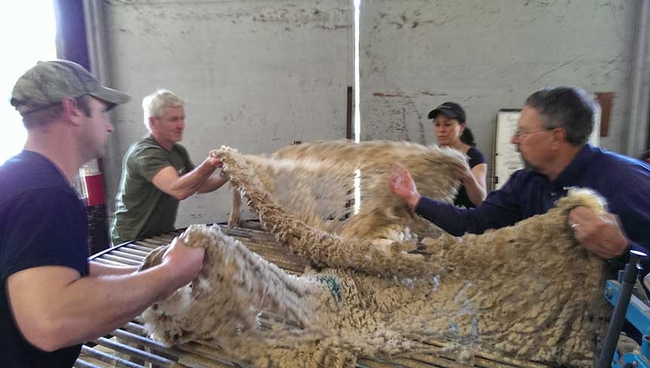
Wool classing.

Stephany Wilkes at the Sonoma County Fair.


